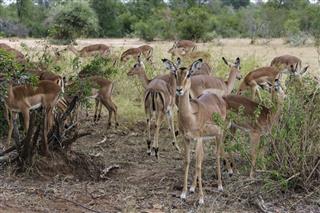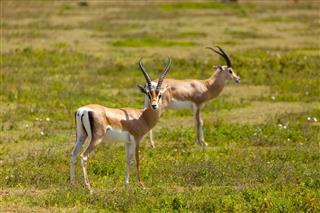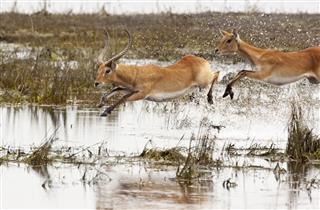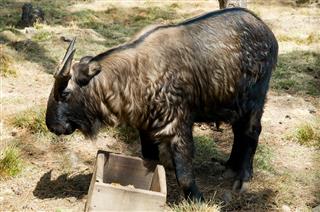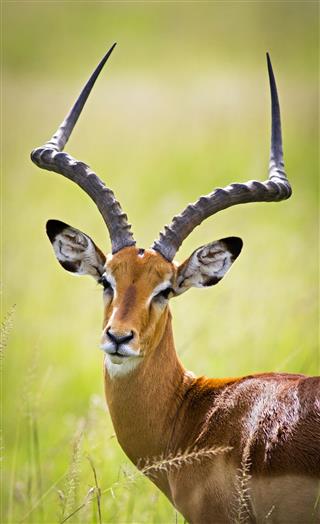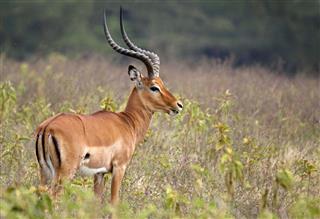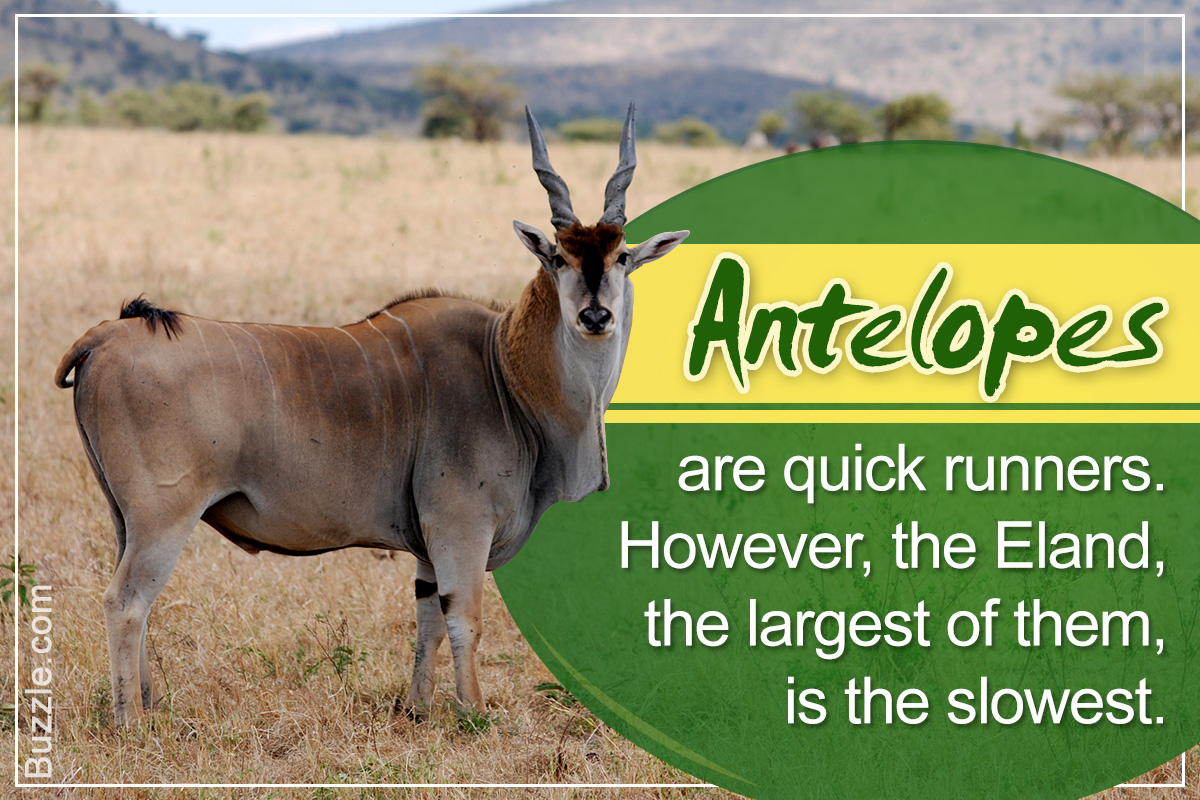
This is a guide to one of the most widespread fauna of Africa, the African antelope. Know about the different species of these herbivores, and have a sneak peek into their existence in the wildness of Africa.
The most number of antelope species inhabit the African continent. Speaking of the major species, they include Wildebeest, Roan, Waterbuck, Eland, Gerenuk, Steenbok, Nyala, Klipspringer, Kudu, Lechwe, Springbok, Sable Antelope, Tsessebe, Impala, and Oryx. Below is a description that will provide you with a brief outlook on each of these species of African antelope.
Species of Antelope Found in the African Continent
Wildebeest

The large plains of East Africa are typical of the wildebeest whose appearance is somewhat different from that of an antelope. There are two species of this animal; the black wildebeest (Connochaetes gnou) and the blue wildebeest (Connochaetes taurinus). There are striking differences between these two in terms of physical built, migration, and habitats.
Under the former type, the male has a shoulder height of up to 120 cm and can weigh 180 kg, while for the female, the measurements include 108 cm in shoulder height and 155 kg in weight. Under the blue wildebeest species, the male stands tall at 150 cm, and weighs 250 kg, while the female, 135 cm and 180 kg respectively.
The black one limits its habitat choices to open grasslands, and migrates over short distances, while the blue one does not mind exploring a variety of habitats, and migrating over distant places.
During migrations, a large number of these antelopes die while crossing the Mara river. Many of them are preyed upon by alligators and some die drowning in the waters.
Roan

With population spread over the regions of West, Central, Eastern and Southern Africa the roan (Hippotragus equinus) also comes under the larger species of antelopes in Africa; the fourth largest.
Roan is called so because of its reddish brown coat.
Easily confused with the sable, this animal’s characteristic features include its cloven hooves, beard like that of a goat, shorter horns, long tasseled ears, and prominent red nostrils.
Many say that the species is a cross between a goat and a horse. The male and female weighs averagely at 270 kg. The male stands tall at 140 cm, and female, 130 cm.
Waterbuck

A white bib under the throat, and rump marked by a white ring, are the characteristic features of this African antelope, found mainly in Western Africa, Central Africa, East Africa and Southern Africa.
A waterbuck (Kobus ellipsiprymnus), contrary to its name, does not spend much time in water. However, in order to escape predators, it might use the water as a refuge.
The male can reach a weight of up to 300 kg and female, 200 kg. Shoulder height of the animal is generally 120 – 136 cm.
The reddish brown coat of the animal may be an indicator of its age, as it gets darker with age.
Eland

Talking about a large African antelope, the eland is apt for the discussion. Currently, it is known as the largest of all antelope species dwelling in Africa.
The eland resides mainly in the central, east and southern parts of Africa. Coastal plains, montane areas, and semi-desert regions constitute the habitat of this animal.
Unfortunately, it is also one of the endangered species of antelope. It has two subspecies; the common eland (Taurotragus oryx), and the greater eland (Taurotragus derbianus).
Bulls can weigh up to 1000 kg and can stand 183 cm at the shoulder. Females can weigh up to 600 kg and have a shoulder height of up to 153 cm.
Gerenuk

The Eastern region of Africa comprises the habitat of this particular long-necked species of antelope known as gerenuk (Litocranius walleri).
One amazing fact about this animal is its extremely low water requirements. The animal does not need to drink water as the water that it derives from the plants it feeds on, is enough to keep it going. That is the reason, this species is mostly found in arid regions of Africa.
The male can weigh 45 kg, and is heavier than the female, which weighs no more than 35 kg. Also, males are taller (up to 105 cm) than females (100 cm).
Steenbok

Another small species of antelopes in Africa is the steenbok (Raphicerus campestris). Found in the southern and eastern African region, it is also known by the names ‘Steinbuck’ or ‘Steinbok’.
It stands 45 – 60 cm tall at the shoulder, and has a diet that consists of low-level vegetation.
Like in the case of gerenuk, even this one can survive almost without drinking water. It uses the moisture from the food it eats to meet its daily fluid consumption.
Nyala

The sexes of the nyala (Tragelaphus angasii) are differentiated from each other by their color. The male antelope is dark brown with vertical white stripes running on its body, while the female is reddish brown, marked with clear white vertical striping.
The water holes of South Africa usually remain crowded with these animals. Also, they prefer living in dense forest areas as they tend to be uncomfortable to dwell in open spaces.
The male nyala weighs up to 114 kg and is up to 110 cm tall, while the female, 58 kg and 90 cm.
Klipspringer

The rocky hills of Africa happens to be the home to this antelope, which is also attributed by the name, ‘rock jumper’.
This animal is relatively smaller than its cousins, and generally reaches 58 cm at the shoulder.
The klipspringer (Oreotragus oreotragus) feeds on rock plants, and while standing it uses the tips of its hooves.
It is well-known for its remarkable jumping skills. It can leap to a height of 25 feet, which is about 15 times its own height. No wonder it is known as the rock jumper.
Kudu

Kudus consist of two sub-species. They are the lesser kudus (Tragelaphus imberbis), and the greater kudus (Tragelaphus strepsiceros).
Lesser kudus populate regions of East Africa. In this type, males can weigh up to 90 kg, and females, 70 kg. Usually, these animals have a shoulder height of 90 – 110 cm.
The greater kudus are characterized by their massively prominent horns which are borne by the males. Their population prevails in the regions of eastern and southern Africa. 190 – 270 kg is the average weight of males, and 120 – 210 kg is for females.
Lechwe

Floodplains and marshy areas are the main habitats of this golden brown animal known as the lechwe (Kobus leche).
It feeds mainly on aquatic plants and is diurnal by nature.
The average statistics of a lechwe is 90 – 100 cm in shoulder height and 70 – 120 kg in weight. The animal makes use of knee-deep water holes to hide from predators.
One interesting fact about the animal is related to its knees. They are covered in certain type of substance that helps in repelling water. In this way, the animal can run faster even when in water.
Springbok

This species of antelope is mostly found in South Africa, and it is the national animal of the country.
It is popular for its repeated feats of high leaps up to 13 feet into the air.
The male weighs between 33 – 50 kg, while the female, 26 – 40 kg.
80 – 90 kph is the top speed that a springbok (Antidorcas marsupialis) can achieve as its running speed.
Sable Antelope

The wooden Savannah in East Africa, Southern Kenya and Southern Africa are inhabited by the sable antelope (Hippotragus niger).
120 – 140 cm is the height of this animal at shoulder, and 200 – 270 kg is the weight that it can attain.
The male is distinctively dark, while the female is chestnut to dark brown.
A sable antelope is known to confront the attacks of predators like lions, using its scimitar-shaped horns.
Tsessebe

A tsessebe (Damaliscus lunatus) has a black stripe running from its forehead to the tip of the nose. Its chest and legs are black, and its coat is rusty red.
The horns of the animal are indicative of its age. This is because, as the animal ages, its horns tend to wear down.
This large species of antelope can attain a height of 150 – 230 cm, with males weighing up to 137 kg, and females, 120 kg.
Impala

Sleek, elegant, and graceful are the words which come to mind while describing a magnificent creature such as the impala (Aepyceros melampus).
This antelope is mainly known for its amazing leaping abilities.
The male impala averagely weighs 46 – 76 kg, while the female, 37 – 50 kg.
This slender creature can be commonly found in places ranging from southern Africa to the northern limits of East Africa.
Oryx

The oryx (Oryx gazelle) is also one of the large antelope species in Africa.
It mainly dwells in near-desert conditions, without water for long periods.
Both the sexes of this species possess horns which are used for protecting themselves and their young ones.
The male can weigh between 167 – 209 kg, and attain a height of 1.2 m.
This article served as a medium to give you a glimpse of a small part of the lives of antelopes that inhabit the great African continent. It is truly amazing to know that the earth serves as a shelter to a wide variety of fauna, who in their respective domain do their bit in maintaining the balance of the ecosystem. In case you come across some more information on this subject, do visit again, and give your inputs via the comment box. Totsiens!
